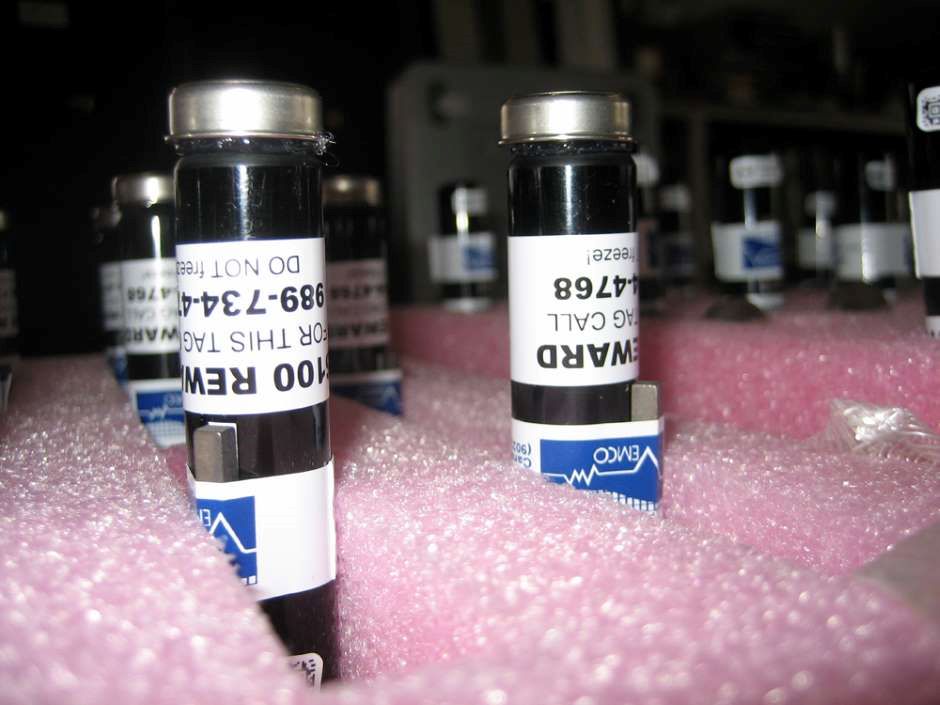Tracking Fish Through Telemetry
 Acoustic transmitters for use in walleye (Credit: Sean Landsman/GLFC)
Acoustic transmitters for use in walleye (Credit: Sean Landsman/GLFC)The batteries are beginning to fizzle in acoustic transmitters sewn up into 200 Great Lakes walleye, soon closing an early chapter on an unprecedented look into the movements of Lake Huron and Lake Erie’s most popular fish.
Those 200 fish were tagged in 2011 in Michigan’s Tittabawassee River and Ohio’s Maumee River for the first of three walleye telemetry projects funded by the Great Lakes Fishery Commission through the Great Lakes Restoration Initiative. The data will help scientists better understand where the fish spend their time, when they spawn and which environmental factors influence them the most.
Why Walleye
“From a purely scientific standpoint, there’s a lot of really cool ecological questions that you can answer with these data,” said Matt Faust, a fisheries biologist with the Ohio Department of Natural Resources who work on telemetry studies.
There’s more than idle scientific curiosity behind the studies. Information about how walleye move around will improve the models that help set commercial quotas and recreational bag limits for one of the world’s most popular catch-and-keep walleye fisheries.
“It’s not like bass or muskie where you’re out there fishing for a trophy and you catch a big one and let it go,” Faust said. “People like to eat ‘em. So the more information we have on where they’re moving and how that directly applies to setting quotas, the better.”
Why Telemetry
The fish tagged in the Tittabawassee and Maumee rivers in 2011 are part of a study looking at where the fish spend time in lakes Huron and Erie and whether they move between the two via the Detroit and St. Clair rivers. This year is the last field season — the transmitters have around a four-year battery life, Faust said. The scientists haven’t fully analyzed data pulled from hydrophones installed around the study area that record pings from tagged fish, but a preliminary look suggests that a small fraction of the population migrates between the big lakes.
A group of researchers that included Faust tagged another group of walleye collected over reefs out in Lake Erie’s western basin where they spawn. It’s not clear how much the reef spawners contribute to the overall lake population.
The third and most recently funded study will tag walleye in the Sandusky River to track the movements before and after the city of Fremont, Ohio, removes the failing Ballville Dam. The Sandusky’s walleye stock was once much more productive than today, and the dam removal could open access to high-quality spawning habitat upstream.
Future Fish Telemetry Research
The Great Lakes Fishery Commission continues to use acoustic telemetry to understand walleye and other fish. The information provided allows bordering states to establish spawn sites and reasoning for these areas being protected from fishing.
Faust said the projects have been backed by effective collaborations from a wide variety of partners, from wildlife and natural resource agencies from Ohio, Michigan, New York and Ontario, as well as the U.S. Geological Survey and Carleton University in Ontario.
“Anyone that has a hand in managing the fishes of interest in the Great Lakes is working together to make these projects as successful as they’ve been,” Faust said.
Before joining the Ohio DNR, Faust worked for the Great Lakes Fishery Commission to develop the Great Lakes Acoustic Telemetry Observation System, whose website serves as an outreach tool and a data repository for telemetry studies across the lakes.



0 comments